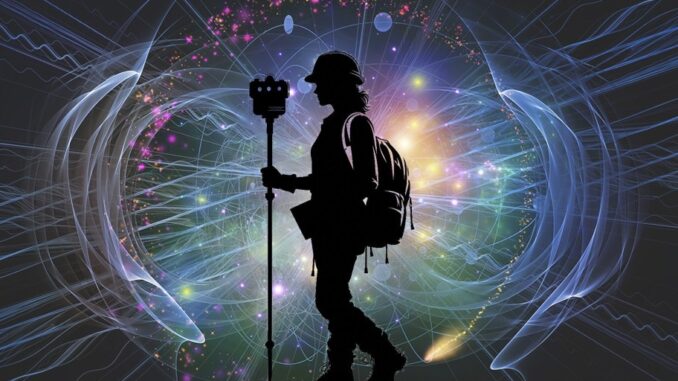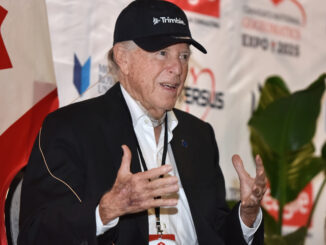
A visit to the Emerging Technologies exhibit at Trimble Dimension+ 2022 had some eye-opening new tech we may see in geomatics of the near future
The name says it all: “emerging technologies”. To some degree, each of the past Trimble Dimensions conferences and exhibitions has featured some of the cool things their R&D folks have been working on. And some elements of those have eventually found their way into hardware and software in their portfolio. However, this year, the conference had a very techie focus, including an emerging technologies showcase in the exhibit hall. The techie theme began with the keynote address, with guest speaker Steve Wozniak (co-founder and tech mastermind Apple), and a video cameo from Microsoft CEO Satya Nadella.

Wozniak relate some tales from his pre-Apple days as a pioneering wunderkind with an insatiable desire to build computers. The “Woz” is colorful character, who does not hold back on his views on life, the universe, and everything… even threw in some zingers about some big-tech companies. One story he related was about R&D for what some folks called a “woznet”, an early way to do location-based services. He said his research into GPS positioning was fascinating, but too complex at the time for what they envisioned.
Trimble has only had three CEOs in its 44-year history, a level of continuity that is almost unheard of in industry. For many in the Trimble user community, it was the first time they had heard current CEO Rob Painter present, and the general consensus among folks we asked was that he did a good job. Painter noted that it had been nearly 1500 days since the last Trimble Dimensions and gave some perspective. In that same time period, Trimble had invested nearly $2B into R&D. And to highlight just how much the world has gone digital and data driven, he quoted the stat that 90% of the world’s data was generated in that same period.
To be honest, accelerated tech for geomatics is not limited to Trimble; we’ve seen a lot of geo-coolness at various events like Intergeo 2022, and other vendor events, but there was a real geo-geek focus on display at this event.
The Coolest Job
Each time I attend Dimensions, I seek out Aviad Almagor, vice-president for technology and Innovation at Trimble (watch his keynote here). Interviews with Almagor are deep-geek and we go off on tangents about futuristic visons for surveying, geomatics, and geospatial. I joke that he has the coolest job; he gets to dream for a living and translate those dreams into related R&D.
“The idea here in our group is to look at early phase technologies, identify potential elements which can impact the future of Trimble and start to develop them up to a level of maturity where there will be attractive for the business,” said Almagor. “During this process, typically we examine customers work, and work with partners like Microsoft Dynamics. We really mature it and integrate it to a level where it’s ready for the commercial use and then help the team when they take it to commercialize it, because it’s basically now the stuff that we’re dealing with here.”
They have a lot of partners, evident in many of the presentations and products, and we’ll look at some below. I asked what the overall focus was for partnerships and their own R&D. “The main umbrella concept is certainly the merging of the digital and the physical. Trimble’s vision historically was connecting the two environments—now we’re talking about convergence. Technology enables us to do so and because we think it’s a much more valuable proposition because a customer would actually prefer such an environment.”
You could call it “industrial metaverse”, “digital twins”, whatever… Let’s not get hung up on buzz terms—geomatics professionals really want to get the “aspirin” that will fix their workflow and data headaches. Almagor gave us a tour of some of those “aspirin” his group is working on. Some are things we have previously only heard about in concept, so it certainly satisfies one’s “inner-geek” to see them first hand and creates anticipation for when such things will be productized.
Neural Signals
We got to try out a wristband they have been working on with a partner, Wearable Devices, that can detect distinct signals in your wrist. You can identify unique ones, like pressing thumb and fore fingered together, then assign actions to each. With this, a demo robodog acted on commands from the wristband. Like stand up, move-forward, fetch coffee…. OK, maybe not that… yet.

Another hands-on demo involved a headset that reads brainwaves. In this case it is to control the speed of a car on a slot-car track. While we see lots of examples of this kind of research in the news, this was for man the first time they could try it out themselves. Trimble had a kind of competition to see who could do the fastest times on the track.
There are very practical applications that could benefit from what looks like a gimmick at first glance. “I did my master’s degree at Cambridge on brain-computer interfaces,” said Almagor. “It’s kind of part of my passion. There are several aspects here that relates to controlling external tools. Some of them are actually being developed to monitor users. For example, we can monitor fatigue very early, even before the user starts to do a kind of movement with their neck. Let’s just play some brainwaves with the monitor.” He gestures to the screen. “This pattern brainwave, which is actually quite common to almost all of us, reflects some fatigue level. Imagine a truck driver or an excavator getting a message to it sit by the way. You can get the message that you should take care; it’s really about improving safety and again connecting technologies that can tell you what you are feeling before you notice it.”
Quantum Underground Mapping
We’re all familiar with metal detectors, traditional magnetometers, GPR, and other technologies to “see” what is underground. There is always room for improvement; making sense of what such sensors “see” (or try to see) is like reading tea leaves. But now there is a lot of research into leveraging sub-atomic level science to detect what is underground. How it works is very deep tech, and I’ll get more details from the PHD folks at Trimble that are working on this for a subsequent article. But I’ll take a stab at explaining it (with my limited understanding).
Elements of quantum magnetometry have been around since the 1960’s, but mostly only in a lab environment, and the components were massive and power hungry. The real jump forward, as in many emerging technologies, is in miniaturization. Just look at no-calibration tilt compensation systems that fit into GNSS rovers, like the R12i. I digress…
Sub-atomic particles like nuclei and unpaired valance electrons spin, and there is polarization which causes the particles to precess (a slow gyration of the rotation axis of a spinning body about another line intersecting it so as to describe a cone with respect to the earth’s magnetic field). The precession can be translated directly into field units. Devices like their demo unit are extremely sensitive, so they can detect changes in this precession that are influenced by differentials between materials underground.
The head of their demo detector is a kind of sealed glass box with rubidium particles inside. It was set up at the bottom of wooden stick with a smartphone on the top. They had a test platform set up with some pipes underneath. Don’t ask me much more about how it works, but it did work well in the test environment. Likely a long road to productization, but this is pretty intriguing technology.
“The advantage of quantum sensors compared to standard is the sensitivity level, so we can track quite accurately any change in the magnetic field,” said Almagor. “Surprisingly enough it could be used, for example, to identify archaeological sites, because it could be connected to change from of human action there perhaps thousands of years ago.”
Related: there is an article in Geoff Zeiss’s Between the Poles blog about research being done, with a goal of underground detection in mind, in quantum gravimetry.
Autonomous Mapping
There is a scene in the Ridley scott film Prometheus where the ill-fated crew lobs a flying orb into the alien ship that automatically maps the corridors. Ok, the scanning part seems easy, but did that orb possess anti-gravity? I digress…

It is inevitable that mapping will become more autonomous. We see those robodogs everywhere, and it seems every manufacturer is putting scanners and cameras on them. There were robodogs wandering around all over Dimensions; they even had one deliver a Trimble hat to Steve Wozniak during the keynote. Mostly, they were remote controlled, but there was a demonstration of one that wandered all over an enclosed area on its own, even going up and down stairs. Certainly, I’m not alone in experimenting with putting a camera on a Roomba to take pictures periodically to process into a point cloud, but they have taken this so many steps more towards a practical solution for autonomous mapping. Plus, they had an X7 scanner onboard.
And they had some of the robot pods that can do follow along to carry gear—an S or SX series total station case fits quite nicely in them. Good thing, those total equipment cases seem to get heavier the older I get… now they need to make an all-terrain version.
Layout Tools
Also on display were fully productized examples of emerging tech. Early in 2022, Trimble launched FieldLink MR, construction layout software that works with a total station and a mixed -reality headset (The XR10, that is based on a HoloLens). My write-up on FieldLink MR here.
But taking this a step further, earlier this year, they released the Ri total station, designed for this kind of workflow for layout.

At Dimensions I finally got to see the Ri in action. It looks a bit different from other total stations, more like an X7 scanner. And this is because it shares many of the design features of the X7, and layout systems like he RTP600. A distinctive feature is the set of ring lights around the lens. I need to find out more of the specifics, but those also have some function related to tracking, and especially for the pole mounted foil type 360 targets (that I hear can outperform traditional prisms in certain situations… will try to find out more about that).

Speaking of layout, one of their partnerships is with HP on the HP SitePrint, a bot that essentially “paints” (to the millimeter) a digital design onto a smooth surface, guided by a total station. Of course, many surveyors will rightly say “that will not work on a messy site”, but for bare floor layout, this thing should rock.
Positioning Through Walls
During a packed presentation, an alternate positioning and navigation solution developed in conjunction with NASA Jet Propulsion Laboratory and DHS was outlined. No traditional RF and far less multipath effects. One of the disadvantages of RF signal-based solutions for indoor applications is poor penetration of walls. However, magnetic fields do much better.

The shorthand description of how this works is: three orthogonal magnetoquasistatic tech. The base has three emitters at right angles, and likewise with three receptors in with the receiver. Between the respective signals from different orientations detected, and their strength, the receiver can determine range and direction. Applications envisioned include positioning indoors for first responders, but there could be many more. The presenters gave caveats about range and thick metal walls, but they said that tests have shown positioning in centimeters. We’ll try to get a demo to test his, but it looks to be a promising new technology that could really solve the conundrum of indoor positioning.
Connew struction Autonomy
Machine control has been on a steady trajectory towards full autonomy (for appropriate applications). At a construction equipment training facility near Las Vegas, Trimble set up a “sandbox”, demonstrating their construction portfolio. Dimensions attendees took shuttles out to the site.

They had a water filled basin to demonstrate the integration of a robotic hydrography boat and an excavator. There was a robotic pile-driver and other equipment with different levels of automatics integrated. But the most intriguing exhibit was one with an autonomous excavator and autonomous compactor, plus a remote-control bulldozer. Potentially, a small site operated by one person.
Analytics
Another demonstration in the emerging tech zone was advanced analytics for systems and infrastructure. As more sensors are added to systems, the data can be analyzed on-the-fly and adjust operations as needed. Like pump or hydraulic systems, detecting if a component is clogged or not operating at full efficiency. The rapid implementation of IoT will bring a wealth of opportunity.
Yes, there was some true deep-geekage at this event. And it was grand.
Header image credit: Varsha Y S via Wikimedia Commons, CC BY-SA





Be the first to comment